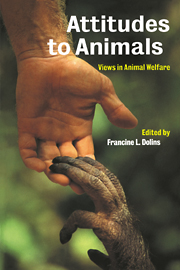Book contents
- Frontmatter
- Contents
- List of contributors
- Acknowledgements
- Part I Attitudes to animals
- Part II Animal awareness
- Part III Animal welfare
- Part IV Research and education
- 12 Humane education: the role of animal-based learning
- 13 ‘Minding animals’: the role of animals in children's mental development
- 14 Alternatives to using animals in education
- 15 Animals in scientific education and a reverence for life
- Part V Epilogue: the future of wild animals
- Index
14 - Alternatives to using animals in education
Published online by Cambridge University Press: 16 November 2009
- Frontmatter
- Contents
- List of contributors
- Acknowledgements
- Part I Attitudes to animals
- Part II Animal awareness
- Part III Animal welfare
- Part IV Research and education
- 12 Humane education: the role of animal-based learning
- 13 ‘Minding animals’: the role of animals in children's mental development
- 14 Alternatives to using animals in education
- 15 Animals in scientific education and a reverence for life
- Part V Epilogue: the future of wild animals
- Index
Summary
Introduction
The use of animals to demonstrate known facts and/or principles still features in many biology courses in secondary schools and, perhaps more significantly in universities, despite a growing ethical concern amongst students and teachers. The morality of using animals in this way is controversial and the issues have been debated by several authors (Orlans, 1988; Langley, 1991; Smith, 1992). Since the introduction of the Animals (Scientific Procedures) Act 1986 in Britain (HMSO, 1987) experiments using live animals in schools have been outlawed, although such experiments are still legal in universities. In the university sector most animals are used in laboratory practicals, designed to supplement formal taught sessions, where they demonstrate known facts or principles. They are also used in undergraduate research projects. The number of animals used in teaching is significant (9164 procedures under Home Office regulations in 1992), although small when compared with the total number of animal procedures (2854046 in 1992) which include those performed in drug and cosmetic testing, medical research, etc. (see Table 14.1).
It might be expected that the high media profile of animal rights issues in recent years, which has heightened the awareness of both teachers and students to the unnecessary use of animals, would have led to a marked reduction in animal experimentation for teaching purposes. In addition, the large increase in the cost of animals (Hughes, 1984) and the decrease in unit funding in higher education would suggest that the use of animal experimentation, at least for teaching purposes, should be decreasing rather than increasing.
- Type
- Chapter
- Information
- Attitudes to AnimalsViews in Animal Welfare, pp. 200 - 217Publisher: Cambridge University PressPrint publication year: 1999



